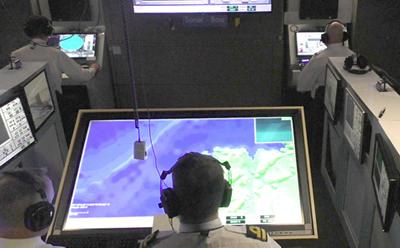Future submarine simulator increases efficiency through new command circle

Pioneering analysis by researchers at the University of Southampton and the Defence Science and Technology Laboratory (Dstl) has found that Submarine Command teams can improve performance by working in an inward-facing circle configuration.
Trials at the University’s Command Teamwork Experimental Test-bed (ComTET), a representative model of a submarine control room, observed greater efficiency and effectiveness when the Officer of the Watch was able to be located in the centre of an inward facing, circular Command team layout.
The findings are helping to inform the design of command space in future submarines in order to optimise information flow.
Future submarine command teams will face the challenges of increasing amounts of data coupled with reduced staffing brought about by increased automation. Effective command decision making in these teams will depend on productive team structures, system functions, interfaces and work design.
The ComTET facility at University of Southampton and a second room simulator at Dstl’s Portsdown West site have been testing a variety of scenarios using a simulation engine based upon a modified commercial gaming software called Dangerous Waters.
ComTET director Professor Neville Stanton, from the University's Transportation Research Group, says: “We have used Event Analysis of Teamwork (EAST) to better understand submarine command team working across different operation types and levels of demand. Through these state-of-the-art simulations we are able to test and evaluate new technologies and new ways of working, with the results already directly influencing future platform design.”
The ComTET programme was launched in 2014 and was initially funded through the Chief Scientific Advisor’s Science & Technology programme. Today, it is a Technology Demonstrator Programme sponsored by the Defence Nuclear Organisation (DNO) with governance and funding provided by the Submarine Delivery Agency (SDA).
Much of the completed work has focused on tactical picture completion to ensure submarine safety, with more recent studies addressing the mission effectiveness aspects of submarine control rooms.
The ComTET project research team has published 12 journal papers in titles including Human Factors; Cognition, Technology and Work; and the Institution of Electrical and Electronics Engineers (IEEE) Transactions on Human Machine Systems.
Chris Parnell, Dstl Technical Partner, says: “Analysis generated during the first stage of the programme using the Southampton simulator was very valuable. It demonstrated that co-location of operators highly dependent on each other for task completion creates greater efficiency in terms of information flow and increases Command team capacity.
“Having operators facing inwards creates conditions for much better shared situation awareness between the Command team; and placing the Officer of the Watch in the centre of the Command team leads to a more efficient tactical picture generation.”
The research is now advancing assessments of new Human Machine Interface (HMI) prototypes that will explore new ways of working for future submarine command teams. This will include alternative roles, new procedures, adjustments to manning and changes to training regimes.